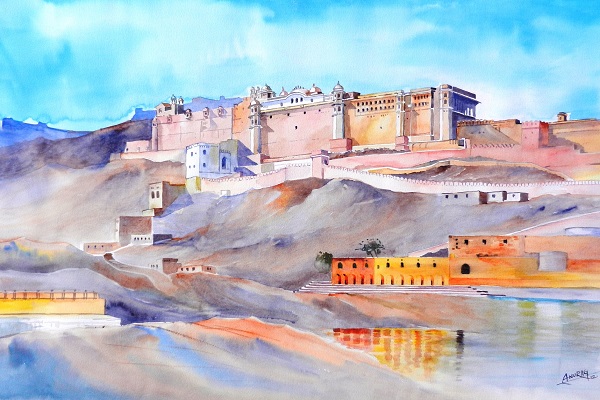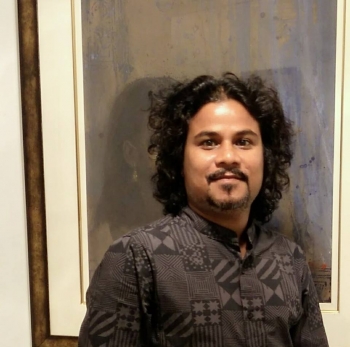
Are you looking for great stories behind the Mughal painting that has been fascinating to you for a long time? Well, here we are!
Mughal paintings have evolved from the Persian school of paintings. Hindus, Buddhists, and Jain art forms and oil paintings have been of a great influence on the art form. The Mughal Art form has grown in India under various Mughal Emperors. Various themes such as battles, huntings, wildlife, royal life, legendary stories, myths, etc have been shown in such paintings.
Mughal Paintings became an important method to narrate one's story and thus made their way to different Indian courts. Victoria and Albert Museum in London has some of the best Mughal paintings.
While learning about Mughal paintings, you can also consider oil painting of your home and office decor. There are various oil paintings for sale available with Indian Art Ideas.
What was the Mughal Style of Paintings?
Mughal paintings and architecture are part of the Indo-Islamic style. They have developed in the patronage of the Mughals. They were developed in northern and central India between the 16th and 18th Centuries. Mughal paintings are a great mixture of Indian art, Turkish art, and Persian Artform and oil paintings. Along with Mughal paintings, they are famous for creating beautiful Mughal gardens under the layout of Persian Charbaghs. Usually divided by flowing water and walkways, Cahbaghs are quadrilateral-shaped gardens.
Origin of Mughal Paintings
They are known to be an amalgam of Iikhanate Persian and ideas and techniques of Indian Origin. The early 16th century was an era of artistic creativity under the Delhi Sultanate when a previously formal and abstract style began to give way to a more energetic and human mode of expression. Following the Mughal triumph over the Delhi Sultanate in 1526, India's miniature painting history shifted away from the Persian style's high abstraction and toward a more realistic manner of portraiture and depicting flora and animals.
You can also get Oil Painting Artwork for Sale at Indian Art Ideas.
Mughal Paintings under the Akbar Period
The magnificently decorated Hamzanama or Dastan-e-Amir Hamza, a recounting of the legendary exploits of Amir Hamza, Muhammad's uncle, is one of the greatest achievements of Mughal painting under Akbar.
This book was exceptional in size, covering 14 volumes and containing 1400 pictures of extraordinarily huge size (about 25′′ x 16′′). It took 14 years and nearly a hundred men to complete (1562–1577).
It took 14 years and nearly a hundred men to complete (1562–1577). In their leaning towards naturalism, the forceful portrayal of movement and emotion, and bold color, the paintings indicate a considerable break from the Persian style. A propensity for diagonals indicates depth.
Mughal Paintings under the Jahangir Period
Emperor Jahangir, like his father Akbar, had a strong interest in painting and had his atelier. Because of the emperor's predilection for portraits, the custom of illustrating books took a back seat to portraiture throughout Jahangir's reign.
Exquisite court scenes picturing him surrounded by his courtiers are among the finest works of his reign. These are large-scale portraiture exercises, and each figure's likeness is faithfully reproduced.
The figures are more formally organized, the colors gentle and harmonious, and the brushwork exceptionally beautiful; the composition lacks the dynamism, movement, and bright color characteristic of Akbar's earlier masterpieces. During Jahangir's reign, Mughal paintings featured exquisite floral and geometric borders.
Which colors were used to paint Mughal Paintings?
In the Mughal Era, the painting techniques used were much simpler. They consisted of opaque watercolors on paper. The Mughal Painting artists laid out thin black and charcoal ink. They were applied with the help of either a brush or a pen. Over the under-drawing, a thin ground—an opaque watercolor layer—was brushed on. This coating, which could be white or colored yellow or blue, protected the paper while allowing the under-drawing to show through. To define important portions of the composition, different colored grounds could be employed. On the ground, another under-drawing was made, this time in red or black and done with a brush in thin watercolor.
So, when it comes to oil paintings, it also becomes easy to get one at online websites. Some of these galleries have oil paintings Artworks for sale.
Famous Mughal Paintings
Now, Mughal painting is a form of South Asian painting dedicated to miniatures, either as book illustrations or as solo pieces to be stored in albums. It originated in North India (more specifically, modern-day India and Pakistan) (muraqqa).
It arose from Persian miniature painting (which was partly Chinese in origin) and flourished in the Mughal Empire's court from the 16th to 18th centuries. Battles, legends, hunting scenes, animals, royal life, mythology, and other subjects have all been featured in paintings regularly. So the Mughal rulers were Muslims who are credited with cementing Islam in South Asia as well as disseminating Muslim (and especially Persian) arts and culture.
As they were at the urge of declining, Mughal paintings made their way to survival. Mughal painting developed an initial interest in realistic portraiture, which was not common in Persian miniatures. Animals and vegetation were the principal subjects of many album miniatures, and they were rendered more accurately.
Hence, many traditional Persian and Indian writings were still illustrated, the Mughal rulers' passion for writing memoirs or diaries, which began with Babur, produced some of the most elaborately drawn texts, such as the Padshahnama genre of official histories.
What Is Special About Mughal Paintings?
The "Mughal aesthetic is cohesive, stretching from architecture to painting—so painting and gardens are related," Navina Najat Haidar, a curator in the Metropolitan Museum of Art's department of Islamic art, told Artsy. Further, the Mughal love of nature and observation of plants is closely linked to the representation of flora and gardens in painting.
So, UNESCO describes Lahore's Shalimar Gardens as the "apogee of Mughal artistic expression." These gardens feature prominently in the miniature paintings, and both speak to the empire's search for refinement and aesthetic pleasure.
Well, this refining was not quick; the empire's first several decades were unstable and chaotic. A revolt in Afghanistan in 1540 caused Babur's son, Humayun, to flee his court to seek military assistance. He sought refuge at the Persian Safavid palace in Qazvin, where he first encountered Persian painting. He reclaimed his home state in 1555, he took two Persian painters back to India with him, Mir Sayyid Ali and Abdus Samad.
Mir Sayyid Ali had demonstrated his talent by painting a polo match on a grain of rice, complete with goalposts and four horsemen, according to legend. Art historian J.M wrote, "Considering Humyn's besieged status and the unlikelihood of his ever regaining a permanent position in India, the employment of two... costly artists while he was still in exile marked a huge investment,". Rogers in his book on Mughal painting.
Each minor work needed a tremendous amount of technological expertise. initially, the paper was trimmed to size and polished before any painting was started. This was done to the point that no ink could penetrate the surface.
Even as individual painters began to claim credit for their work, the labor-intensive paintings remained the outcome of a massive workshop's teamwork.
Wrap up:
Along with Original oil paintings for sale, you can also look in for Mughal paintings. At Indian Art Ideas- you can get a handful of paintings of all types.
Read more about Mughal paintings while buying a few with us; along with Buddha Paintings.





















